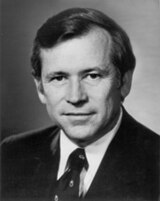| 95th United States Congress | |
|---|---|
94th ← → 96th | |
 United States Capitol (c. 1970) | |
January 3, 1977 – January 3, 1979 | |
| Members | 100 senators 435 representatives 5 non-voting delegates |
| Senate majority | Democratic |
| Senate President | Nelson Rockefeller (R) [a] (until January 20, 1977) Walter Mondale (D) (from January 20, 1977) |
| House majority | Democratic |
| House Speaker | Tip O'Neill (D) |
| Sessions | |
| 1st: January 4, 1977 – December 15, 1977 2nd: January 19, 1978 – October 15, 1978 | |
The 95th United States Congress was a meeting of the legislative branch of the United States federal government, composed of the United States Senate and the United States House of Representatives. It met in Washington, D.C., from January 3, 1977, to January 3, 1979, during the final weeks of Gerald Ford's presidency and the first two years of Jimmy Carter's presidency.
Contents
- Major events
- Hearings
- Major legislation
- Constitutional amendments
- Treaties ratified
- Party summary
- Senate
- House of Representatives
- Leadership
- Senate 2
- House of Representatives 2
- Caucuses
- Members
- Senate 3
- House of Representatives 3
- Changes in membership
- Senate 4
- House of Representatives 4
- Committees
- Senate 5
- House of Representatives 5
- Joint committees
- Employees
- Legislative branch agency directors
- Senate 6
- House of Representatives 6
- See also
- Notes
- References
- External links
The apportionment of seats in this House of Representatives was based on the 1970 United States census. Both chambers maintained a Democratic supermajority, and with Jimmy Carter being sworn in as president on January 20, 1977, this gave the Democrats an overall federal government trifecta for the first time since the 90th Congress ending in 1969.
As of 2022 [update] , this was the most recent Congress to approve an amendment (the unratified District of Columbia Voting Rights Amendment) to the Constitution. This is the last time the Democratic Party or any political party held a 2/3 supermajority in the House.
This is the last congress to at any point have no female senators (from its beginning, January 3, 1977, until the swearing-in of Muriel Humphrey (D-MN) on January 25, 1978; and again from the departure of both Humphrey and Maryon Allen (D-AL) on November 7, 1978, to the early swearing-in of Nancy Kassebaum (R-KS) on December 23, 1978).













